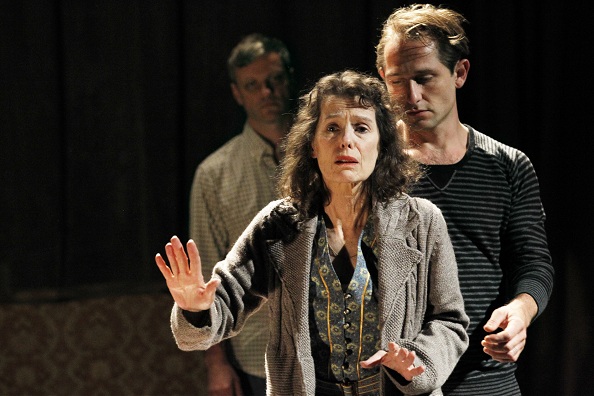Kage Physical Theatre in partnership with Alzheimer’s Australia
Melbourne Arts Centre
May 8-13, 2012
By Tamara Searle.
Sundowner is a dance theatre work that proposes to give a voice to the unspoken subject of Alzheimer’s dementia, and to pay tribute to and reflect the courage required by sufferers and carers. Sundowner uses the language of physical theatre to tell the story of a woman who suffers from Alzheimer’s, and her family. It is tragic, but also funny in its treatment.
A voice over of a young boy invites you to meet his grandmother, a writer, who is a ‘bit different’, in the study of her home. The grandmother, played with extraordinary compassion and nuance by Helen Morse, can’t figure out how to do up her shoes any longer, so she cuts the laces off; she wears her cardigan back to front, lovingly readjusted by her daughter, over and over again; she often can’t remember where she is; and she talks every day to the friend she meets in the mirror. She remains a master at the crosswords, but she tells the same joke again and again. She has Alzheimer’s dementia.
After meeting the grandmother we are drawn into her memory and fantasies where we are introduced to her son (Stuart Christie), daughter (Michelle Heaven), and late Husband (Gerard Van Dyke). We see physicalized the memories of the woman – caring for her children, with her children when they are young, on Rosebud beach, romancing with her husband. The dancers in our protagonist’s memory and fantasy evoke emotional states such as the weight that the woman carries with her when aware of the state she is subsiding into, and the desperate attempts to run away from her inexorable void of forgetting. There is also a chorus of five fine, silver-haired music hall tappers. Perhaps these are angels who have already passed on? They are exquisite and joyful, filled with the pleasure of dance, and gorgeously costumed by Paula Levis. These fantasies and memories are played out in the study of the woman, and through the window of the woman’s home, which is veiled by a curtain and when lit from behind reveals a scene. We also see the role of carer once inhabited by the mother, inverted and assumed by the daughter in a series of physical motifs.
Central to the narrative of Sundowner are the woman’s attempts to re-enter her creative world as a writer. Her frustration builds as each time she realises anew she is no longer capable of the sustained thought required to write. The audience is privy to our protagonist growing more and more agitated over her inability to work. At the height of the woman’s fury and desperation, her daughter enters. The woman no longer recognises her daughter. Seeing her daughter as a threat, she tries to keep her away. The horror of Alzheimer’s is nowhere more manifest than in this scene. Her daughter begins to cry at the decline in her once astute, erudite mother, and ironically the woman doesn’t realise her daughter is crying over her, and begins to comfort her, briefly adopting the role of carer once more. Sundowner achingly achieves its aim of tribute to the courage of carers and sufferers in this moment.
One might imagine that Sundowner is a dark work without redemption, however there is much humour, intelligent dramaturgy, and playful performances which make the complexity of the issue accessible.
Photo by Jeff Busby.















